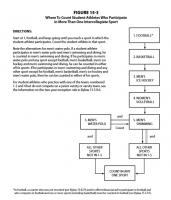UTMVol76
Heup Train
- Joined
- Oct 1, 2010
- Messages
- 12,982
- Likes
- 33,879
No, it's a back count, meaning he counts towards the next year. I guess we could be saying the same thing, but at the end of the day it counts towards next year.
Bylaw 15.5.6.3.3 A student-athlete not recruited (per Bylaw 15.02.8) by the institution who receives institutional financial aid (based in any degree on athletics ability) after beginning football practice becomes a counter but need not be counted as an initial counter until the next academic year if the institution has reached its initial limit for the year in question. However, the student-athlete shall be considered in the total counter limit for the academic year in which the aid was first received.
Someone correct me if I'm wrong, but I think the rule actually reads that if a player plays multiple sports, the scholarship counts against the highest revenue sport. Most assume that is football, and in 99% of cases, it is, but not necessarily.Football trumps all other sports when it comes to scholarships. I think it’s a way to prevent hiding football players on no revenue teams.
The rule could in fact read that way, and you would be correct, that’d be football errtime.Someone correct me if I'm wrong, but I think the rule actually reads that if a player plays multiple sports, he scholarship counts against the highest revenue sport. Most assume that is football, and in 99% of cases, it is, but not necessarily.
Not quite. Football does trump, but it's not based on revenue. Here's the chart from the manual showing the order of precedence.Someone correct me if I'm wrong, but I think the rule actually reads that if a player plays multiple sports, the scholarship counts against the highest revenue sport. Most assume that is football, and in 99% of cases, it is, but not necessarily.

I stand corrected. Thanks!Not quite. Football does trump, but it's not based on revenue. Here's the chart from the manual showing the order of precedence.
View attachment 256755
